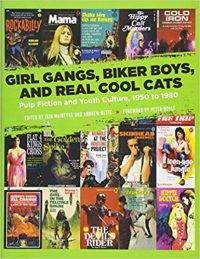The development and the origins of pulp fiction books are both well-documented and naturally before there was a market for those products, there was a demand for it. Girl Gangs, Biker Boys, however, starts not at the beginning of this genre, but dives deep into the phenomenon of the pulp books that dealt with subcultures and youth cultures. Those books that on their respective covers promised crime, passion, sex, violence and maybe a hint on why those vices were found in just that teenage environment.
 Naturally, the audience those cheap publications wooed for at the newsstand were mostly adults of the much older generation, trying to come to terms with the shocking and unpardonable behavior of the current generation of teenagers; thereby satisfying their appetite for a little action, voyeurism and erotic suspense. Since many of the works dealt with the rage „of the day,” i.e. the contemporary subcultures, traditionally posing a threat to those who live in the midst of society and those who were almost haunted by the “real-life and authentic” stories of the young ones.
Naturally, the audience those cheap publications wooed for at the newsstand were mostly adults of the much older generation, trying to come to terms with the shocking and unpardonable behavior of the current generation of teenagers; thereby satisfying their appetite for a little action, voyeurism and erotic suspense. Since many of the works dealt with the rage „of the day,” i.e. the contemporary subcultures, traditionally posing a threat to those who live in the midst of society and those who were almost haunted by the “real-life and authentic” stories of the young ones.
„It‘s an old story now that successions of youth subcultures, each more bad-mannered and unruly than the one before, provided one of the most durable panic refrains of postwar public life in the west. Ad hoc alliances of tabloid journalists, social workers and media commentators eagerly identified and sensationalised each emerging type. In the late 1940s, early 1950s it was juvenile delinquents, of course. Then came beatniks. And bikers. Gays and lesbians. Hard-dope fiends. Later on, hippies and countercultural types, mods, rockers, surfers, skinheads, youthful revolutionaries. Trippers, potheads ad ravers. Rock musicians and groupies….Often the group in question was represented in faux anthropological terms as a kind of tribe, obviously…..”
The list of pulp titles mentioned in Girl Gangs, Biker Boys and those with a review and short synopsis is very long. It includes Drummer (Richard Carlile, 1971), A Hero Ain’t Nothin’ But a Sandwich (Alice Childress, 1973), Acid Temple Ball (Mary Sativa, 1969), Odd Girl Out (Ann Bannon, 1957) and The Leather Boys (Gillian Freeman, 1961) among many others. Numerous were written under a nom de plume by journalists or writers trying to earn a fast buck (those titles were generally rather good). Then there were pulps of terrible quality that simply copied other authors’ plots and added fantasy sociological expressions, sex cults, drug abuse and all kinds of horror that would ensure the books’ success. If the title failed, it would not be a great economic loss for the publisher, as expenses for authors, paper and print were very low and a similar book could be produced quickly.
The majority of those pulps is long out of print. Others were reprinted, and some served as inspiration for commercially successful movies, often produced many years later, such as Up the Junction (1966), The Beat Generation (1959), The Outsiders (1968), The Warriors (1965), Go Ask Alice (1971) and numerous biker movies of the 1970s.
A fine study of pulp’s greatest moments, focusing on juvenile crime, youth culture and subculture fashions in the US, England and Australia. Editors Ian McIntyre and Andrew Nette masterfully arranged the 400+ book cover reproductions (many originals that today are rare collector’s items) and some 70 interviews with pulp authors.
The twenty contributors – among them David Rife, Bill Osgerby, Mike Stax and Alwyn W. Turner – in seven chapters enlarge on juvenile delinquents, 1960s beats, hippies and drug cults, pulp fiction music novels, motorcycle gangs, 1960s British youthsploitation novels and the rise of the teen novel in the 1970s. Not to forget the use of dyed paper, that gives the over sized paperback that extra pulp look. Very informative and entertaining, this volume makes you want to keep your eyes open on your next visit to the flea market or garage sale.
Review by Dr. A. Ebert © 2018
Iain Mcintyre and Andrew Nette (eds.) Girl Gangs, Biker Boys, And Real Cool Cats: Pulp Fiction and Youth Culture, 1950 to 1980. PM Press, 2017, 328 p.
